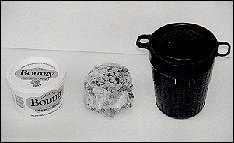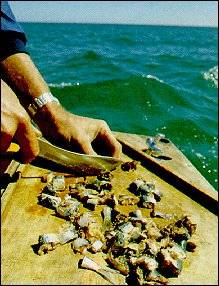Berleying
What is Berleying ?
One would think that the word "berley" is a global and generically used term in fishing. It is not - where infact it is a uniquely an Australian term. The British call it "ground baiting", where as the Americans call it "chumming". Berleying is simply the process of attraction and containment of fish around your bait, by means of scent, taste and sight.
Most of us are aware and understand the purpose of berleying, but there is a technique involved in realising the complexities of the correct method to berleying. Berleying is achieved by cutting up small pieces of bait, adding bread or other "starchy" ingredients, and slowly dispersing this concoction into the sea where you are fishing. The most important feature of any berley mixture is its ability to be detected by fish in very small quantities, attracting the fish to the source.
Berley also provides a trail of scent for the fish back to the source, but don't confuse a strong odour with a bad smell. Very few fish are attracted by rotten fish or meat odours. Some substance, such as fish oils (tuna, pilchard, sardine), cheese, blood, prawn and lobster scraps are great in enhancing the smell of your berley. Ingredients such as cereal, bread, bran and pollard are then used to absorb these oils, and then allowed to disperse along the berley trail, attracting the fish.
The idea of berleying is to attract and tease the fish into the vicinity of your bait. Over-berleying will cause the fish to hang back at the limit of the berley stream, providing them with a well nourished meal without ever coming within range of your bait. Fish have an extremely keen sense of smell, and it is the smell of the juices and oil from your berley that first alerts the fish to a potential free appetizer, where your bait is the main course !
Now that you have got all the basics to berleying down, there is one final but important rule - don't stop !
Once the berley is in the water, it's critical to ensure an unbroken trail leading back to your location. Any significant break in the berley trail can cause the fish to lose interest and turn away, often following the pool of berley that attracted them in the first place.
Using a berley bucket is an ideal way of ensuring a constant berley trail, and that the berley is distributed sparingly.
How to berley is just as important as Where to berley. Its pointless pouring berley in at a point where a six knot run will sweep it away in seconds. It is much better to berley an eddy, a bay or an area behind a breaking reef, where it will give the berley a chance to hang around.
 When using "starchy" ingredients such as cereal, bread or bran and pollard with your berley, you must allow time for this ingredient to become fully soaked. Otherwise it will tend to float at the surface. This doesn't matter too much if the area you are fishing is less than about 15 metres or if the fish you are trying to attract are surface and mid-water species, but if you are deep water with strong currents, another approach is needed. When using "starchy" ingredients such as cereal, bread or bran and pollard with your berley, you must allow time for this ingredient to become fully soaked. Otherwise it will tend to float at the surface. This doesn't matter too much if the area you are fishing is less than about 15 metres or if the fish you are trying to attract are surface and mid-water species, but if you are deep water with strong currents, another approach is needed.
Adding sand to the berley bucket will help it reach the bottom, or mixing sand with your berley mix into a fairly dry, dough-like mix and rolling it into golf-ball size lumps will do. Dropping these berley bombs over the side every 4 to 7 minutes and combined with your berley bucket (berley pellets soaked in tuna oil) will work wonders.
Beach Berleying
Using berley when fishing the beach takes a lot of patience because waves tend to scatter it in all directions. You will find that plenty of bread used on an outgoing tide will keep tailor and bream in confined areas for a long periods of time, and a little oil can be used with the bread as an added attractor.
The spots most favoured for beach fishing are when a formation occurs where there is a good hole, close to shore, with the back of the hole opens to the sea. Schooling Mulloway are one fish that respond very quickly to fish scraps soaked in oil, but be aware that sting rays plus Pt Jackson sharks can be attracted to this berley as well.
Excess water movement is the biggest drawback in beach berleying, so during times of big seas, or where there is a strong rip, save your berley for another occasion. Its not worth the effort, or berley !
Using tennis-ball sized handfulls of premade berley are often effective when lobbed at timed intervals into a deep beach gutter or hole. A mixture of pilchard cubes or other fish scraps weighted with sand will slow the berley's movement and keep it close to the bottom where it will be most effective.
Small gutters found running out from the corner of beaches are also a prime berleying location, particularly if they are rock-studded gutters.
Berleying off the Rocks
 When Rock Fishing, the most widely employed technique involves tying a piece of rope to a good sized tuna or other oily fish, then dangle it down into the water's edge. With the constant influx of surge and pounding waves, it usually doesn't take long before you have a top berley slick constantly feeding out into the wash. When Rock Fishing, the most widely employed technique involves tying a piece of rope to a good sized tuna or other oily fish, then dangle it down into the water's edge. With the constant influx of surge and pounding waves, it usually doesn't take long before you have a top berley slick constantly feeding out into the wash.
If tuna proves too hard to get, use Aussie Salmon, a couple of Tailor, or an onion bag packed with fish offal and offcuts, pilchard, bread and oil.
Another method is to use a 2 litre plastic bottle with an onion bag of berley to act as a float, and attach a bottle of tuna oil with several small holes pierced in it to spread a continuous oil slick around the bag and contents. It will definitely attract fish ! This technique is a sure fire method of scoring bream, trevally, snapper and tailor off the rocks.
Usually, the first fish to show in a berley stream are small baitfish, which off course, soon leads to bigger and better fish. Often hanging deeper and well back from the berley are bream, trevally, tailor and snapper, so always probe the deeper outskirts of the berley slick with a lightly weighted bait.
As well as the home made berleys, there is a great number of natural berleys that can be found right at the fishing ledge. Crab offcuts, crushed shellfish, cockles, barnacles, limpets and any other crustaceans or shell fish you can gather all make superb berleys. Always look at the surroundings of the fishing ledge, to try and identify sources of potential ingredients for your berley. However, you must make sure that the collection of shell fish is legal in the area that you intend to collect them.
Berley Oil
Since the protection of whales, the most widely available and popular berley additive is tuna oil. Most good tackle suppliers should carry a range of varying sized bottles of tuna oil at reasonable prices.
The list of fish that can be attracted by tuna oil is large. However, tuna oil has two things going against it. Firstly, tuna oil is very hard to get out fo your hands for some time after handling the berley or making the mixture of berley. Secondly, it is a great attractor of sharks. To minimise this occuring, its best to use small or diluted amounts of tuna oil when making your favourite brew of berley.
In all cases, tuna oil is a worthy additive that can make your berley extremely attractive to fish.
Berley Recipes
The following berley mix is ideal for spring sinkers and berley floats. I've seen squid off the jetty attracted by this brew.
- Pellets
- Bran or Pollard
- White Bread, cut into small squares (no crust)
- The secret ingredient - Curry Powder
Mix the above with water until the brew takes on a stiff consistency. Use just enough Curry Powder to give the brew a light yellow colour. You should mix a batch several hours prior to usage, to ensure that enough time is given for the pellets to absorb some moisture. Garfish can quite easily fill up on your berley, so the right consistency of berley mix is critical in ensuring that the mix does not disperse to quickly.
my Ruffs will die for this berley as well !
I found the following recipe in a fishing magazine some time ago. Its reputed to be one of the best berley recipes for attracting Bream.
- 6 kg Wheat
- 1/2 kg of Bran and Pollard
- 1/4 kg Plain Flour
- 1/2 Bucket of Dry Sand
- 1/4 Cup of Tuna Oil
Mix all the ingredients together in a large plastic bucket. Cover the ingredients with boiling water, and place a lid on the bucket. After 1 hr, top up the mixture again with boiling water. By this time, the wheat would have started to absorb the water and swell, and the flour stiffen the mixture, which will hold it together. When berleying, drop the mix over the side in tight handballs and it will sink straight down and gradually dissolve on the bottom, thus bringing the fish into the area.
Give the berley time to work and be sure to put your bait into the berley stream. There's no point in getting a healthy, tasty slick going, attracting good numbers of fish to feed in the stream and then putting your hook outside the area of activity. So keep an eye out on the direction of the current and tidal flows to get the benefit of your efforts.
 Fishing Tip : Fishing Tip : |
|
| Why not contact fishSA.com about your Fishing Tip |
|
|